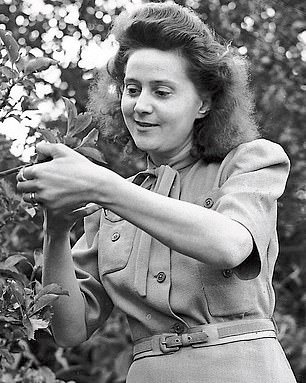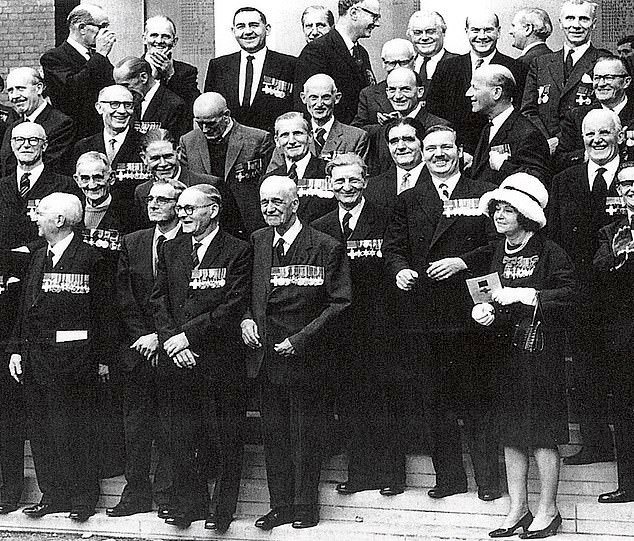In 2019, Sophie Parker was at residence in Surrey, going by a e book that had belonged to her grandmother. Tucked contained in the pages she found a leaf. It was small; no bigger than slightly finger. Parker, now 57, was surprised. Shortly, she advised her elder sister, Nicole Miller-Arduous, 61, who was residing in New Zealand.
When Miller-Arduous flew again to the UK, Parker met her they usually drove to current the leaf to the Imperial Warfare Museum. Within the automotive, Parker positioned the leaf in her sister’s hand. ‘I couldn’t consider it,’ says Miller-Arduous.
‘This little veined piece of inexperienced presumably saved my grandmother’s life.’
Parker and Miller-Arduous’s grandmother was Odette Hallowes – a Frenchwoman who was a part of the British Particular Operations Government within the Second World Warfare. The SOE, because the organisation was recognized, was shaped in 1940. Its brokers had been educated to conduct reconnaissance and sabotage in Nazi-occupied Europe and to work with native resistance armies. Members of the SOE had been additionally required to be fluent within the language of the nation they had been infiltrating.
Hallowes joined the SOE nearly by chance: in 1942, the UK authorities requested British residents to ship any vacation images that they had of the North French coast.
The thought was to analyse the shoreline, by as many photos as potential, forward of the D-Day landings. Hallowes – 30 on the time and residing in Somerset with three daughters, all ten and beneath, and a British husband within the Military – submitted a variety and a letter. The SOE discovered her response and should have been impressed: inviting her to London, they requested her to affix.

Odette in 194
She despaired for occupied France however didn’t wish to go away her kids. Till then, she been a mom and housewife and had zero expertise of working as a undercover agent – or, because the SOE known as it, conducting ‘ungentlemanly warfare’.
However finally she agreed. The youngsters had been enrolled in a boarding college and Hallowes wrote them pre-dated letters, to open week by week. ‘Issues like “I hope you’re doing all of your homework”, or “I hope you’re not biting your fingernails,” says Miller-Arduous.
What satisfied Hallowes to affix? ‘She had this very robust sense of obligation,’ says Parker. ‘Her personal father was killed within the First World Warfare and her grandfather used to take her and her brother to go to their father’s grave each Sunday. He would say to them, “There may be going to be one other world conflict. I do know it’s coming. And when it does, it will likely be your flip to do your obligation, simply as your father did his.” I feel these phrases turned engraved throughout her coronary heart.’
SOE coaching was rigorous. Hallowes discovered self-defence, the way to parachute, use explosives, learn Morse code and resist interrogation. When she arrived in France she joined a fellow SOE agent, Peter Churchill, they usually labored intently with a radio operator, Adolphe Rabinovitch, who coded and decoded messages.
Hallowes was additionally despatched on solo missions and coordinated aerial drop-offs of weapons and gear. On one mission, she missed the final prepare residence and needed to spend an evening in a brothel in Marseilles that was frequented by Nazis; on one other project she hid from German forces at night time in a freezing river.
However in 1943, Churchill and Hallowes had been betrayed by a double agent and arrested by the Gestapo. Pondering rapidly, Hallowes advised the officer that she and Churchill had been married, and that he was Winston Churchill’s nephew. This was a lie – the shared surname was purely coincidence. She reckoned a faux connection to the Prime Minister would possibly spare them each execution.

Odette (backside proper) on the twenty fifth Anniversary of the George Cross at Guards Chapel, London, 1965
Hallowes was despatched to occupied Paris, the place she endured interrogation and torture. She was burned on her again with a red-hot poker; her toenails had been pulled out one after the other. The Gestapo needed to extract data from her concerning the SOE, however Hallowes saved quiet. ‘She mentioned it was so simple as making the choice, “I’m not going to talk”,’ says Parker.
‘She mentioned as soon as she had made that call, it was simple to stay to it.’

Odette (far left) at a household operate with granddaughters Sophie (second proper) and Nicole (center), Eighties
Additionally, Parker provides, ‘They made one elementary mistake after they had been torturing her: they positioned her in a chair that was dealing with a window.’ The Gestapo constructing by which Hallowes was being interrogated was on Avenue Foch – an infinite avenue in an costly space of the capital. It was lined with bushes and ended on the Arc de Triomphe.
Hallowes was in a room a number of flooring up and, from the window, she might see the tops of the bushes. ‘She mentioned, “I simply determined I needed to transport myself away from the place I used to be and put myself in these bushes.” I suppose it was what we’d consider right this moment as going into some type of meditative state.’
Hallowes was incarcerated within the Paris jail, Fresnes, and saved in solitary confinement. The Nazis condemned her to dying on two counts: for being a British spy and for working with the French Resistance. Hallowes’s response was usually defiant: ‘Gentleman, you could take your decide of the counts as a result of I can solely die as soon as.’
And so, precisely 80 years in the past this month, in June 1944, Hallowes was despatched to Ravensbrück in Germany, an all-female focus camp with greater than 50,000 prisoners. She was once more positioned in solitary confinement, in an underground cell with no gentle.
Hallowes sat alone in whole darkness for 3 months and 11 days. She was subsequent door to a punishment cell and will usually hear prisoners being tortured; she had no idea of whether or not it was night time or day. Based on Miller-Arduous, Hallowes discovered a tiny piece of wooden within the cell and would polish the ground with it: ‘That saved her sane.’
Because the winter of 1944 approached, Hallowes was moved to a cell on the bottom flooring of the camp, which had a small window. One morning, she was despatched to the Ravensbrück hospital and on her approach again, crossing the compound, she noticed one thing on the bottom: a small leaf. The leaf was uncommon – there have been no bushes overhanging the fences of the camp. Hallowes picked it up and guards appeared to not thoughts. ‘A leaf was not one of many issues a prisoner [was] forbidden to have,’ she wrote in a later memoir.
‘They had been completely unconscious of the importance of the treasure I had acquired. They didn’t know, as they slammed the door of my cell, that I held in my fingers a most potent hyperlink with the forces of life and of freedom.’

The leaf Odette present in Ravensbrück
Day after day in her cell, Hallowes would look at the leaf, tracing its veins and backbone along with her fingertips. The act related her with the skin world from which she had been eliminated. ‘It appeared to me,’ she wrote, ‘that I touched not a leaf however a tree.’
By early 1945 it was changing into clear that Germany was shedding the conflict and the commandant of Ravensbrück was rising anxious. Nonetheless believing Hallowes was associated to Winston Churchill, he determined to hand-deliver her to the Individuals.
Parker thinks he hoped it would grant him some clemency. As an alternative, the Individuals arrested the commandant on Hallowes’s instruction and confiscated his gun. Hallowes herself saved the weapon in secret for the remainder of her life; her household solely found it many years later, after her dying.
On the night time of her launch, the Individuals supplied Hallowes a heat place to sleep, however she declined. After so many months trapped in a cell she mentioned she needed to really feel the contemporary air. She was reunited along with her kids – in keeping with Parker, ‘she was so skinny they barely recognised her’ – and settled again in Britain.
She divorced her first husband, Roy, and, making good on the lie she advised the Gestapo, she married her SOE accomplice Peter Churchill in 1947. The couple divorced in 1956. Hallowes then married one other former SOE member, Geoffrey, they usually had been collectively till she died in 1995, aged 82, at residence in Surrey.
Her postwar life, it appears, was a contented and well-decorated one. There was a movie, Odette, made about her in 1950, and Hallowes was awarded an MBE, the George Cross and the French equal, the Légion d’Honneur.
She saved her medals at her mom’s home in Kensington – till they had been stolen in a housebreaking. Hallowes’s mom appealed to the press, and the thief, obligingly, posted the medals again with a be aware. He apologised for the theft, promised he was ‘not all that dangerous – it’s simply circumstances’, and signed off beneath the title ‘A Dangerous Egg’.
Nonetheless, for all Hallowes’s accolades, Parker and Miller-Arduous don’t keep in mind her discussing her SOE work usually – and when she did it was to acknowledge her feminine SOE colleagues who didn’t survive. As an alternative, their grandmother’s work was revealed in unstated indicators: her ongoing cough, instances of bronchitis, frequent visits from the physician to are inclined to her wounded ft.
Hallowes was frank and unromantic concerning the conflict and its penalties. Within the ultimate paragraph of her memoir she wrote about Ravensbrück, saying, ‘Navy victory was gained and I used to be one of many few who returned to inform the story… However now I ask myself the extent of the victory. With nice unhappiness I consider that the selection made between liberty and slavery has nonetheless to be made. We used to consider in Ravensbrück that these of us who survived might enter a extra tolerant and tranquil world whose leaders would have learnt the age-old lesson that man is made in God’s picture and should bear God’s dignity.
Within the conflict we fought a human enemy; one who had been contaminated with the germ of inhumanity. Though we defeated the enemy we didn’t defeat the parasite. That very same parasite of inhumanity is concerning the world right this moment and, until it’s destroyed utterly, the camp of Ravensbrück will solely be the shadow and the image of a larger darkness to return.’
As we speak, Hallowes’s leaf is saved in Parker’s residence. It’s 80 years previous, barely shrivelled and curling on the ends. However someway it has remained tinged a comfortable inexperienced.
‘It’s extraordinary,’ says Parker. ‘There are nonetheless life forces in that leaf.’
#leaf #saved #spy #grandmother #Nazis #alive #focus #camp #treasured #possession #granddaughter #reveals #extraordinary #story
